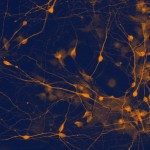Lien vers Pubmed [PMID] – 8841664
Acta Neuropathol. 1996 Aug;92(2):180-5
The aim of this study was to analyze the relationship between apolipoprotein E (ApoE) and amyloid beta-protein (A beta) deposits in 29 brains from a series of elderly women, whose intellectual status had been prospectively assessed by the Blessed test score (BTS). In three cases the APOE genotype was epsilon 3/4, in one epsilon 2/2, in 25 epsilon 3/3. ApoE-like immunoreactive lesions resembling a classic senile plaque (ApoE-SP) or a diffuse deposit (ApoE-DD) were quantitatively assessed in the first temporal gyrus (Brodmann’s area 22). The density of ApoE-positive deposits (ApoE-SP+ApoE-DD) was correlated with BTS (negative correlation R2 = 0.36, P = 0.0006). The correlation of the density of ApoE-DD with BTS (R2 = 0.26, P = 0.0051) was weaker than that of ApoE-SP (R2 = 0.50, P < 0.0001). The density of ApoE deposits was correlated with that of A beta-immunoreactive lesions (positive correlation R2 = 0.57, P < 0.0001). ApoE immunohistochemistry labeled fewer deposits than A beta immunohistochemistry but showed as many senile plaques (ApoE-SP) as tau immunohistochemistry and the Gallyas and Bodian techniques. Two of the three cases with the epsilon 3/4 allele had Alzheimer's disease (AD) with numerous ApoE-immunoreactive senile plaques. In contrast, the brain of the third epsilon 3/4 case, whose intellectual status was normal, contained numerous A beta deposits but lacked ApoE-like immunoreactivity. The presence of ApoE may, thus, not be a prerequisite for A beta deposition, even in cases with the epsilon 3/4 allele. The density of ApoE-SP peaked in layer III, whereas that of ApoE-DD was maximal in deeper cortical layers. This contrast in the laminar distribution indicates that only some ApoE-DD may evolve into ApoE-SP. ApoE deposition was linked to the intellectual decline and was constant in the most severely demented patients, in whom numerous ApoE-positive (and A beta-positive) neuritic plaques were surrounded by dystrophic neurites. ApoE may accumulate in neuritic senile plaques during the progression of AD.
